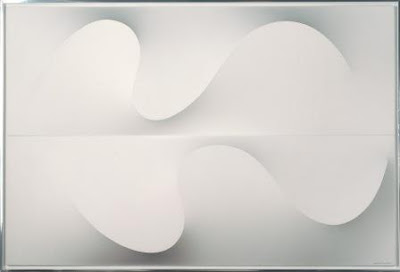

Playing With Color and Movement
By SONIA KOLESNIKOV-JESSOP (Times Herald Tribune)
Published: September 8, 2009
SINGAPORE — “Everything can be simplified in the basic shapes of lines and angles,” Anthony Poon once said. That spirit of experimentation, characteristic of the abstract art movement in the 1960s and 1970s, is highlighted in a major retrospective of the work of the late Singaporean artist. The show explores how Poon methodically developed his style, eventually finding a distinctive voice with relief painting.
“Light and Movement Portrayed: A Tribute to the Art of Anthony Poon,” which runs until Oct. 25 at the Singapore Art Museum, features works representing the artist’s different phases, from his formative years painting in an Abstract Expressionism style to his embrace of Optical Art, subsequent innovations in relief painting and final venture into sculptural works.
While earlier Singaporean artists had generally adhered to the renditions or representations of the physical world in their paintings, Poon pushed for the use of abstraction and is generally regarded as a forerunner of the modernist art movement in Singapore, said Kwok Kian Chow, director of the National Art Gallery in Singapore (set to open in 2013) and the former director of the Singapore Art Museum.
Born in 1945, Poon studied at the Nanyang Academy of Fine Arts between 1961 and 1964, and his early works, like “Fishing Village” (1966), show the influence of Cheong Soo Pieng, one of Singapore’s pioneer modern painters and one of his teachers at the academy.
“You can see this in the elongation of the necks and limbs, this is classic Soo Pieng, as well as the subject matter, a fishing village,” said Ong Zhen Min, the curator of exhibition.
However, the semi-abstract “Jobless Son” (1966), with its vibrant hues of blue and graduation of greens, already hints at the young artist’s interest in color.
In 1967, Poon went to Britain to further his studies. Amid the vibrant London art scene of the 1960s, which was then breaking away from Abstract Expressionism and experimenting with the styles and movements that responded to it, his eyes opened up to a new world of theories. These ranged from Geometric Abstraction and Hard-Edge painting, in which abrupt transitions are made between areas of different colors; to Color Field, where solid colors are spread to create a flat plane with no brushstrokes; and finally, to Optical Art.
By the time Poon returned to Singapore in 1971, his practice had changed profoundly to embrace this new form. This is most evident in the first series after his return, the Kite Series. Here he used “shaped canvas” — a term describing supports that departed from the traditional rectangular format and emphasized the work as an object. In these paintings, the artist took an almost mathematical approach, first using graph paper to ensure the complete symmetry of the repeated, precisely arranged shapes that would create an optical effect of moving patterns. “He was very clear-cut in what he wanted and had very set ideas about what the perfect ratio should be,” Ms. Ong said, adding that Poon’s undulating repetitions somewhat recall the work of modular constructivist sculptors like Erwin Hauer and Norman Carlberg.
“Many artists at the time were interested in seeing if they could match technological development with the art world,” she said. “They were quite inspired by whatever technological innovations were happening. In the case of Anthony Poon, you can see this in his Colour Frequency Wave Series, which started in the late ’70s and explored the curvilinear form of a frequency wave.”
Throughout his Wave series, Poon strictly adhered to the systematic use of colors — titling his works using the codes of paint color charts (e.g. CR for cadmium red). This makes the technical aspects of his practice a key point in the interpretation and appreciation of his works, Ms. Ong said.
In 1983, Poon won a local art competition with one of his Wave paintings, helping to raise his profile and make him a sought-after artist for public commissions.
A large part of the retrospective focuses on the artist’s three-dimensional Wave relief series, which he started in the mid-’80s. Here Poon created a sculptural effect of sinuous wave patterns by using aluminum strips under the stretched canvas. If a viewer is standing at a distance and directly in front of the painting, it looks two dimensional, but if the viewer moves from one side to the other, the metal strips that push the canvas forward transform it into an attractive sculpture. The artist reinforced the 3-D image with painted shadow effects, but the paint is so evenly applied it looks as if it has been air-sprayed.
“He actually never told anyone how he managed to create the 3-D effect; it was a trade secret for a very long time,” said Ms. Ong. Poon’s wife and daughter agreed to explain the technique for the purposes of the exhibition.
From the three-dimensional relief Wave series, it was a natural progression for the artist to move on to metal sculpture, and from the early 1990s until his death in 2006 he mainly focused on that medium, creating numerous, giant twirls of steel, inspired by the movement of dance and ribbons. Interestingly, his late sculptures show a newfound texture, which Ms. Ong suggested indicates that “he was trying to go full circle, as he’d started with brush strokes and that was a way of putting them back in.”
No comments:
Post a Comment